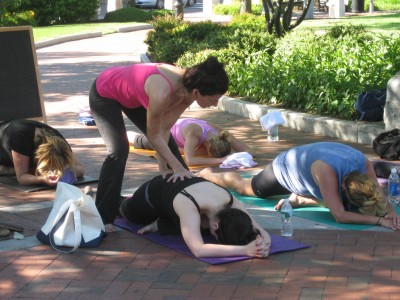I”ve been reviewing the contents of the chapters in my soon-to-be-released book, “Stretched: Build Your Yoga Business, Grow Your Teaching Techniques,” over the past few days and we’re up to Chapter 4, titled “Building the Infrastructure of Your Yoga-Preneurship.” It might sound a bit out of sorts in a book about yoga teaching to have a word like “infrastructure,” but it reflects the idea of building a foundation, a structure, that will support you as you grow your yoga business. As we know from the practice of yoga, without foundation and structure, the pose will lack both steadiness and strength. The same idea applies to your business. And, if you teach full time, let’s face it: you’re in business for yourself. You’re an entrepreneur.
This chapter will give you the nuts and bolts of a suggested format to use to build your yoga business. It’s geared more towards the independent teacher versus the studio owner as these are two very different models when it comes to setting up your yoga teaching career. If you decide to teach on your own versus owning a studio, you’ll find that you have somewhat more freedom but by the same token the challenge is that you can only be one place at one time. From a business perspective, you’re single threaded, not scale-able, and as a result, you can only be earning money when YOU are doing SOMETHING.
Because of this, it can be helpful to create passive sources of revenue. Things like DVDs, books or partnerships where your content is shared with others and you are reimbursed in some way for being the creator. It also suggests that if you have a blend of revenue producing activities versus only one kind of activity (such as studio classes), you can start to build a business with a blend of activities for which some earn you more money than others. This becomes very important to the success of your business, because if you only do one thing at one price point and you’re the only one that can do it (think: studio teaching), you most likely would have to teach so many classes a week it’d be physically impossible. I often ask new teachers to do a simple calculation. Use a figure of $50 to represent what you might be paid for teaching a studio class. Then, take your monthly budget. If you don’t have one, just use the figure for your rent or mortgage, car payment and utility bills. Let’s say this comes to $3000 per month. If you divide that by 4 weeks (in a month), that comes to $750 per week you’d need to earn just to cover these expenses. If you take $750, divide by $50 a class, you get 15 classes a week. That’s more than 2 classes a day. Now, while you might say, “Sure, I could teach 2 classes a day!” Great. But the challenge will be 1- can you find enough locations in your area to book 2 classes a day? 2- Do you want to set yourself up for teaching every single day? 3- How will you generate the additional money you need to live (since we know we only covered a handful of expenses in the exercise above) 4- how sustainable is this kind of lifestyle?
As you can see, it’s a challenging equation to calculate. I go into a lot of detail in this chapter and include in the appendix of the book the spreadsheets I use to track all of the information that has gone into building my yoga business for the past (almost) 4 years. Let me say also that I am by no means making well beyond my expenses. I am just about covering them and some days, when I have unexpected expenses, like a car or home repair, it can really set me back. But I have total confidence in the infrastructure I’ve set up because I know it tracks trends, allows me to easily see the trends in revenue ( both up and down), which allows me to plan better, make better decisions about the viability of my business and helps me identify areas where I’m doing well and areas where I need to improve.
There’s so much detail in this chapter that I’ll stop there for now rather than continuing on and overwhelming you with information. Suffice it to say that this chapter will take you through a reality check. It’s one I wish I had done back in 2003 when I first quit my corporate job to teach yoga. It’s a chapter I wish every yoga teacher would read before ever quitting his or her regular job to teach full time. I do not by any means want this to sound like depressing, spirit squelching information. I want it to be information which allows teachers to make informed decisions about the career of teaching yoga. I’m not talking about teaching on the side here; I’m talking about teaching full time. This is the idea that often draws people to trainings; the idea that one day, they’ll leave their full time job to be a full time yoga teacher. Just read this Chapter before you quit.
Next up: Chapter 5 Resume Creation and Marketing Your Classes

